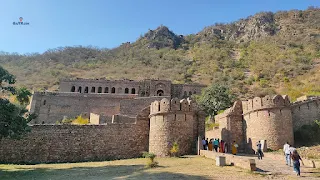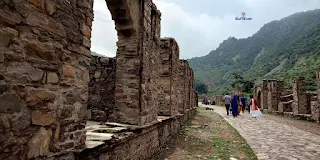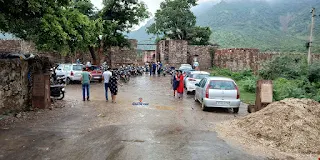Secrets of Bhangarh Fort - Most scary place in India, it tells about the Bhangarh Fort that is the most scary and mysterious place in India and Asia.
{tocify} $title={Table of Contents}
Bhangarh Fort, along with being surrounded by the forests of Sariska, contains many mysterious stories and scary history in itself.
This fort is counted among the scariest places not only in India but also in Asia. Every detail of this fort tells an unknown story.
The fear is that no one stays here after six in the evening. In this regard, the Archeology Department has also put up a warning board.
Tour and Specialty of Bhangarh Fort
There is space for parking of vehicles at some distance from the Hanuman entrance of the fort. At some distance on the right side, there is a big tomb, nearby which are also the remains of one or two smaller tombs. This fort is surrounded by hills in the middle of the forest and is protected by a rampart.
There are five gates to enter this fort, which are known as Ajmeri, Lahori, Hanuman, Phulbari and Delhi gates respectively from north to south.
As soon as you enter the Hanuman gate, you come across the temple of Hanumanji. After taking the blessings of Hanumanji and going ahead, many other remains including Modon Ki Haveli are visible.
The main remains here include ramparts, gates, markets, mansions, temples, royal palaces, chhatris and tombs etc.
Going further from here, one comes to a market in which remains of shops are visible. These remains are in a row on both sides of the road and have a similarity. This market was known as Johari Bazaar.
Going ahead of Johri Bazaar, there are big and scary trees which give a scary feeling. Beyond this, after crossing a big door, a big field comes in front.
Gopinath temple is built on a high platform on the right side of this door. Apart from the Gopinath temple, the main temples here are the temples of Someshwar, Keshav Rai and Mangala Devi which are built in Nagara style. The special thing about the temples here is that all of them are without statues.
There is a beautiful pond ahead on the left side, after crossing which, Someshwar Temple is built. There is a mansion built at some distance from this pond which is known as Purohit ji's mansion.
When seen standing near the pond, this place appears very picturesque and imaginative. Just by imagining that time, that era becomes visible all around us.
It seems as if Princess Ratnavati is crossing the pond with her friends and going towards Someshwar Temple.
After crossing a door from here, the entrance of the royal palace is visible. There are many Kevada flowers planted on the right side of this palace.
The royal palace is considered to have seven storeys but now only four storeys are left. There was an entire settlement in front of the royal palace which was protected by three ramparts.
Inside the palace there are ruins all around. Now call it the mood or the effect of the environment here, all these ruins appear quite scary at many places. There are said to be many basements beneath the palace, with which many scary stories are associated.
There is a strange and heavy feeling in this fort even during the day time, which is made more mysterious by the fragrance of Kevada flowers.
Along with tourists, people who perform tantric rituals also keep coming here. Those who practice Tantra practice secretly here. The chhatri built on the hill above is said to be the main place for those who perform tantric rituals.
Apart from being a famous tourist spot, this place is also a great location for shooting films and serials. Till now many films have been shot in this fort.
History of Bhangarh Fort
If we talk about the history of this fort, we come to know that the fort of Bhangarh was built by Raja Bhagwant Das in 1573 AD, which was later made his capital by his son and brother of Raja Mansingh, Madho Singh.
It is noteworthy that Madho Singh was Diwan in the court of Mughal emperor Akbar. After Madho Singh, his son Chhatar Singh took over the reins of this place. After him, his son Ajab Singh took over the throne.
Due to shortage of water in Bhangarh area, Ajab Singh built a fort named Ajabgarh at a distance of a few kilometers from here. Adequate water was available in this area. Ajab Singh made Ajabgarh his residence instead of Bhangarh.
Due to the increasing influence of the Mughals, later the rulers here changed from Rajput to Muslims, in which Mohammad Kulin took over the power of Bhangarh and Mohammad Dalhij took over the power of Ajabgarh.
Jai Singh, the ruler of Amer, attacked Bhangarh and Ajabgarh in 1720 AD and made it a part of the Amer state. In this war, both the Muslim rulers of Bhangarh and Ajabgarh were killed.
Stories behind the destruction of Bhangarh Fort
Three stories are very famous behind the destruction of Bhangarh. Further, all three stories are told one after the other.
First story behind the destruction of Bhangarh Fort
According to the first story, the princess Ratnavati here was very beautiful. Apart from being beautiful, she was also knowledgeable in occult sciences.
A Tantrik named Sindhu Sevda alias Singhiya became fascinated with this princess and started making various efforts to get the princess. When all his efforts failed, he decided to get the princess through Tantra Sadhana.
For this purpose, one day he somehow gave the promised perfume to the maid who had gone to the market to buy perfume for the princess.
When the maid gave that consecrated perfume to the princess, the princess understood that this perfume was consecrated by the Vashikaran mantra.
The princess used that perfume on a stone due to which the stone started moving towards the Tantrik and crushed it to death.
While dying, the Tantrik cursed Bhangarh to never be inhabited, as a result of which the city was destroyed that very night.
Second story behind the destruction of Bhangarh Fort
According to another story, a saint named Balunath lived here. When the fort of Bhangarh was built, he had warned the king that the height of the fort should never be so high that his penance place would be covered in its shadow, if this happened then the city would be destroyed.
Later, the kings did not pay heed to the sage's advice and increased the height of the fort so much that the penance place of Balunath was covered in the shadow of the fort. Bhangarh was destroyed due to the sage's wise words.
Third story behind the destruction of Bhangarh Fort
According to the third one, in 1720, Raja Jai Singh of Amer defeated the Muslim ruler of Bhangarh and established his control over it.
There was always a shortage of water here and due to a severe famine in the year 1783, this fort was completely destroyed.
If the nearby people are to be believed, then out of the above three stories, the one about the Tantrik's curse is believed to be true and the Tantrik's curse is also believed to be the reason behind the destruction of Bhangarh.
Some people believe that the souls of those who died untimely death due to the curse still wander in the ruins of Bhangarh.
How to go from Jaipur to Bhangarh?
Bhangarh can be reached from Jaipur through two routes. One route goes from Jamvaramgarh via Andhi village. By going through this route the distance to Bhangarh is about 77 kilometers.
The other route is via Dausa from Jaipur Agra National Highway. By going through this route the distance to Bhangarh is about 86 kilometers. As soon as we reach near the fort, our mind starts filling with excitement.
If you are fond of traveling and want to feel the thrill of Bhangarh Fort, then you must go to Bhangarh once and experience that thrill.
Map Location of Bhangarh Fort
Photos of Bhangarh Fort
Writer
Ramesh Sharma {M Pharm, MSc (Computer Science), PGDCA, MA (History), CHMS}
Connect With Us on Social Media
Subscribe Our English YouTube Channel
Subscribe Our Hindi YouTube Channel
Subscribe Our Travel Guide YouTube Channel
Disclaimer
The information given in this article for educational purposes has been taken from various online and offline sources whose accuracy and reliability are not guaranteed.
Readers should take the content of article as information only. Apart from this, the responsibility of any of its use will remain with the user himself.











